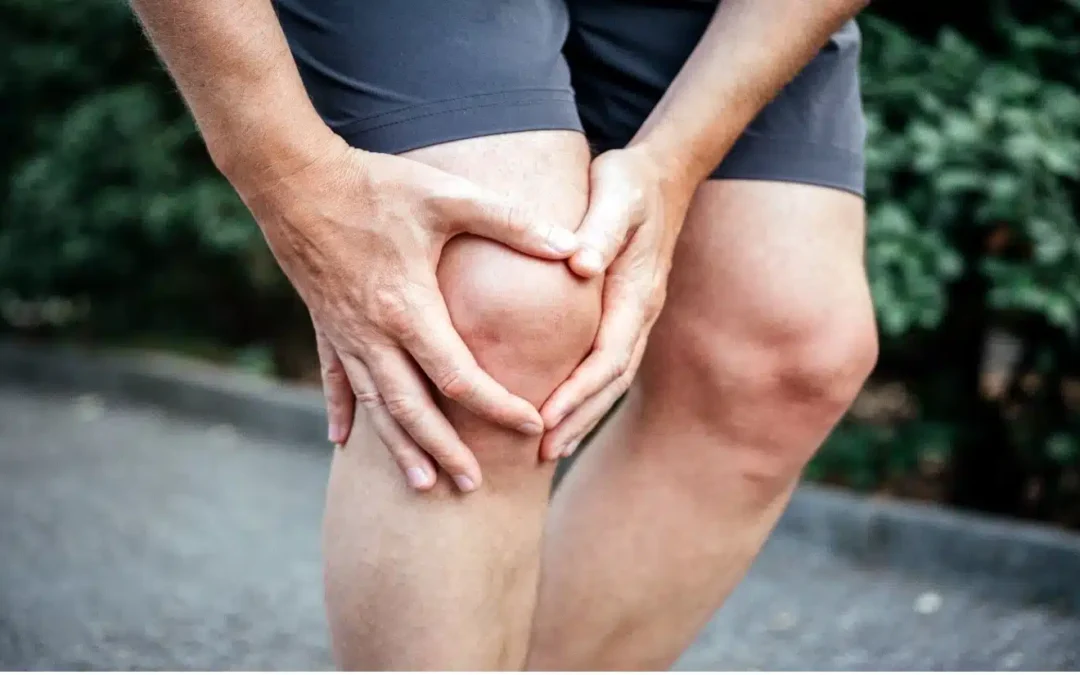Joint pain limits your participation in life. It impacts daily activities and restricts your choices.

There are many potential causes of stabbing ankle pain. Injuries, degenerative conditions, autoimmune conditions, and even wearing shoes that are too tight can cause sharp, severe ankle pain. In some cases, ankle pain can be relieved through RICE (rest, ice, compression, and elevation) — or new shoes! For others, surgery or regenerative ankle treatment may be necessary. Let’s explore several causes of ankle pain and swelling, then learn when to seek professional help.

Ankle sprains and strains are the most common cause of ankle pain. They occur when you twist, turn, or roll your ankle too far. A sprained ankle overstretches or tears the ligaments that connect the bones and stabilize the joint. A strain is when the muscles or tendons of the ankle are stretched or torn.
Both ankle sprains and strains cause severe pain, swelling, and limited range of motion. A severe sprain may also involve bruising, while a strain may cause muscle spasms. A doctor can accurately diagnose whether your injury is an ankle sprain or a strain.
The best response to a moderate ankle sprain or strain is promptly implementing RICE treatment at home. However, if the pain or swelling is severe, making it too painful to walk or bear weight, if the joint is visibly deformed, or if a couple of days of rest and therapy do not significantly reduce the pain and swelling, seek medical attention.
An ankle sprain or strain injures the support structure of your ankle, leaving it vulnerable to re-injury. The following will help you prevent another strain or sprain:
A car accident, sports injury, or the same trauma that causes a sprained or strained ankle can also fracture one or more of the three ankle bones. A fractured ankle requires more intensive intervention and greater recovery time than a sprain or strain. An improperly healed fracture also has an increased chance of long-term complications.
If you have injured your ankle and suspect it is fractured, you should seek immediate medical attention. Signs that indicate your ankle is fractured instead of sprained or strained include:
Your doctor should order an x-ray to confirm your injury is a fracture rather than a sprain or strain.
A simple ankle fracture may just require immobilization while the bones knit. However, more complicated or complex fractures may require surgery. A simple fracture can heal within six to eight weeks, while a complex break takes longer. Once the bones have knitted, strengthening exercises, flexibility training, and an ankle brace will help complete your recovery.
In addition to breaks, sprains, and strains, several underlying conditions can cause ankle pain and swelling.
Inflammatory conditions like rheumatoid arthritis and gout can increase pain in any joint and cause stabbing ankle pain to occur suddenly.
Rheumatoid arthritis (RA) is an autoimmune disease that causes painful swelling of one or more joints. Osteoarthritis (OA) is a degenerative joint disease that breaks down the cartilage that cushions the bones within your joints. Both conditions can cause ankle pain and swelling of the joint. RA typically causes throbbing, aching pain, while OA is more often a dull ache. However, both can be the cause of stabbing ankle pain.
Gout and bursitis of the ankle cause severe pain, swelling, and lost range of motion in the joint. Gout is a type of inflammatory arthritis that involves a buildup of crystalized uric acid in a joint, often starting in the big toe. Bursitis is the painful swelling of small, fluid-filled sacs called bursae. These bursae cushion the muscles, tendons, and bones of your joints.
Gout primarily affects the extremities and is related to dietary factors, alcohol consumption, and genetics. Bursitis is most common in larger joints and is generally triggered by repetitive movements or pressure. Both conditions can cause severe ankle pain.
While rheumatoid arthritis, osteoarthritis, gout, and bursitis have different causes, some common approaches to alleviating inflammation and pain exist. Nonsteroidal anti-inflammatory drugs (NSAIDs) can reduce inflammation and relieve pain for these conditions. Resting and elevating the ankle (or affected joint) also provides relief for each.
More specific pain relief and anti-inflammatory treatment for each condition include:
Physical therapy and alternately applying heat and cold can improve circulation, reduce swelling, and alleviate pain.
Intra-articular corticosteroid injections, physical therapy, and alternating heat and cold can temporarily relieve joint pain and inflammation.
Management typically involves specific medications, rest, and icing the affected joint. Weight management and diet changes are also highly recommended.
Rest, ice, and corticosteroid injections are the most frequent treatments for bursitis. In some severe cases, surgical intervention may be required to drain the bursae.
Tendinitis is an inflammatory tendon condition caused by overuse or repetitive strain. Tendinosis describes the degeneration of the tendon’s collagen, which leaves the tendon weaker and lacking elasticity, leaving it vulnerable to tearing. While both conditions typically cause chronic pain, each can occasionally cause stabbing ankle pain.
Sometimes, a pinched nerve or a nerve disorder is the cause of ankle pain.
Tarsal tunnel syndrome, a compression of the posterior tibial nerve, can cause sharp, shooting pain in the ankle. It is essentially a pinched nerve resulting from a prior ankle injury. The buildup of scar tissue or cysts may grow to compress the nerve. Sometimes, overuse of the ankle before an injury fully heals leads to tarsal tunnel syndrome.
Another nerve condition that can cause stabbing ankle pain is Complex Regional Pain Syndrome (CRPS). Believed to be a dysfunction of the central and peripheral nervous system, CRPS causes severe, persistent pain that is disproportionate to the injury. It typically develops after an injury, surgery, stroke, or heart attack.
Until your doctor recommends a course of action, anti-inflammatory drugs or over-the-counter pain relievers can help. Strengthening exercises and stretching are also beneficial. If the pain is intense, ask your doctor about corticosteroid injections.

As we have discussed, there are steps you can take to address and relieve ankle pain on your own, particularly when you know the cause. But there are several clear signs that it is time to seek medical attention:
Instead, promptly use RICE (rest, ice, compression, and elevation). If you notice significant improvement over a few days, your self-treatment is a success and likely all you need. However, if the symptoms worsen or you note any of the red flags described in this article, seek prompt medical attention.
Don’t look at ankle pain as an inconvenience. Instead, consider it a signal to be more proactive about your health. While a conventional doctor should set a broken bone, many other causes of pain in the ankle can be successfully treated with regenerative medicine. QC Kinetix offers non-surgical, drug-free regenerative therapies that leverage your body’s innate healing abilities to relieve pain, boost joint function, and improve range of motion.
To learn more, visit our regenerative medicine blog or check out our QC Kinetix patient reviews. Our regenerative medicine FAQs provide good general information. However, the best way to learn what regenerative therapies can do for your specific issue is to schedule a free consultation, where we will review your medical records and perform a thorough evaluation so we can best advise you on your options.
Contact QC Kinetix today to find out how we can help you experience genuine pain relief.

Joint pain limits your participation in life. It impacts daily activities and restricts your choices.


QC Kinetix Joint & Bone Health supplements help your body to repair and renew injured joint tissues, including cartilage, ligaments, and tendons, while reducing inflammation of the bursae. Unlike steroids or pharmaceuticals, our supplements for joints work with your body to promote healing.
Supplements can boost your overall joint health as part of a general fitness program. However, they are particularly valuable for treating damaged or inflamed and painful joints. The Arthritis Foundation finds that joint health supplements show promise for relieving pain, stiffness, and other symptoms of arthritis.

*Fill out the form below, and an expert will reach out to you shortly. All fields must be completed.
*Please allow 30-60 minutes of allotted time to meet with a specialist to determine if you are a candidate for our services. Exams are included and are complimentary.
